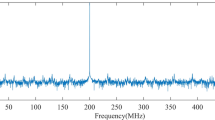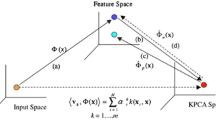Abstract
In the anti-jamming field of radio communication, the problem of online and multiclass jamming recognition is fundamental to implement reasonable anti-jamming measures. The incremental small sphere and large margin (IncSSLM) is proposed, this model can learn the compact boundary for own communication signals and known jamming, which relieves the open-set problem of radio data. Meanwhile it can also update the model of classifier in real time, which avoids the large memory requirement for vast jamming data and saving much time for training. The core of proposed method is the small sphere and large margin (SSLM) approach, which makes the spherical area as compact as possible, like support vector data description (SVDD), and also makes the margin between them as far as possible, like support vector machine (SVM). In other words, it can minimize intra-class divergence and maximize inter-class space. Therefore, there is a significant enhancement of recognition performance when compared with open classifiers such as SVM, and considerable superiority of training efficiency when compared with the canonical SSLM algorithm. Numerical experiments based on synthetic data, practical complex feature data of high-resolution range profile (HRRP), and jamming data of radio communication demonstrate that IncSSLM is efficient and promising for multiple and online recognition of vase and open-set radio jamming.






Similar content being viewed by others
Explore related subjects
Discover the latest articles, news and stories from top researchers in related subjects.References
Yan Q, Zeng H, Jiang T, Li M, Lou W, Hou Y T (2016) Jamming resilient communication using MIMO interference cancellation. IEEE T Inf Foren Sec 11(7):1486–1499
Ho-Van K, Do-Dac T (2018) Reliability-Security Trade-Off Analysis of cognitive radio networks with jamming and licensed interference. Wirel Commun Mob Com 2018:1–15
Wu Z, Zhao Y, Yin Z, Luo H (2017) Jamming Signals Classification Using Convolutional Neural Network. In: Proceedings of IEEE International Symposium on Signal Processing and Information Technology. Bilbao, Spain, pp 62–67
Azami M E, Lartizien C, Canu S (2017) Converting SVDD scores into probability estimates: Application to outlier detection. Neurocomputing 268:64–75
Wang G, Ren Q, Jiang Z, Liu Y, Xu B (2017) Jamming classification and recognition in transform domain communication system based on signal feature space. J Syst Eng Electron 39(9):1950–1958
Yue G, Wang X, Madihian M (2007) Design of Anti-Jamming Coding for Cognitive Radio. In: Proceedings of IEEE Global Telecommunications Conference. Washington, pp 4190– 4194
Huang W, Liu Z, Lv L, Wang L, Zhang S (2018) A novel Anti-Jamming driven sparse Analysis-Based spread spectrum communication methodology. Int J Pattern Recogn Arti 33(01):1958001
Yue G, Wang X (2009) Anti-jamming coding techniques with application to cognitive radio. IEEE T Wirel Commun 8(12):5996–6007
Cauwenberghs G, Poggio T (2001) Incremental and decremental support vector machine learning. in proc of advances in neural information processing systems, Vancouver, pp 409–415
Laskov P, Gehl C, Kruger S, Muller K (2006) Incremental support vector learning: analysis, Implementation and Applications. J Mach Learn Res 7:1909–1936
Molina J F G, Zheng L, Sertdemir M, Dinter D J, Schonberg S, Radle M (2014) Incremental learning with SVM for multimodal classification of prostatic adenocarcinoma. Plos One 9(4):e93600
Xie W, Uhlmann S, Kiranyaz S (2014) Incremental learning with support vector data description. In: Proceedings of international conference on pattern recognition, Stockholm, Sweden, pp 3904–3909
Tax D M J, Laskov P (2003) Online SVM Learning: from Classification to Data Description and Back. In: Proceedings of IEEE Workshop on Neural Network for Signal Processing. Toulouse, pp 499–508
Xu J, Xu C, Zou B, Tang Y Y, Peng J, You X (2019) New incremental learning algorithm with support vector machines. IEEE T Syst Man Cy-S 49(11):2230–2241
Cheng S, Shih F (2007) An improved incremental training algorithm for support vector machines using active query. Pattern Recogn 40:964–971
Gu B, Quan X, Gu Y, Sheng V S, Zheng G (2018) Chunk incremental learning for cost-sensitive hinge loss support vector machine. Pattern Recogn 83:196–208
Katagiri S, Abe S (2006) Incremental training of support vector machines using hyperspheres. Pattern Recogn Lett 27:1495–1507
Laxhammar R, Falkman G (2014) Online learning and sequential anomaly detection in trajectories. IEEE T Pattern Anal 36(6):1158–1173
Liu Y, Liu M (2017) An online learning approach to improving the quality of Crowd-Sourcing. IEEE ACM T Netw 25(4):2166–2179
Ristin M, Guillaumin M, Gall J, Van-Gool L (2016) Incremental learning of random forests for Large-Scale image classification. IEEE T Pattern Anal 38(3):490–503
Jain L C, Seera M, Lim C P, Balasubramaniam P (2014) A review of online learning in supervised neural networks. Neural Comput Appl 25(3-4):491–509
Chen C L P, Liu Z (2018) Broad learning system: an effective and efficient incremental learning system without the need for deep architecture. IEEE T Neur Net Lear 29(1):10–24
Deng W, Hu J, Zhou X, Guo J (2014) Equidistant prototypes embedding for single sample based face recognition with generic learning and incremental learning. Pattern Recogn 47:3738–3749
Krawczyk B, Woźniak M (2015) One-class classifiers with incremental learning and forgetting for data streams with concept drift. Soft Comput 19(12):3387–3400
Vapnik V N (1995) The nature of statistical learning theory. Springer, New York
Maldonado S, Lopez J (2017) Robust kernel-based multiclass support vector machines via second-order cone programming. Appl Intell 46(4):983–992
Wu M, Ye J (2009) A small sphere and large margin approach for novelty detection using training data with outliers. IEEE T Pattern Anal 31(11):2088–2092
Guo Y, Xiao H, Fu Q (2017) Least square support vector data description for HRRP-based radar target recognition. Appl Intell 46(2):365–372
Li C, Liu K, Wang H (2011) The incremental learning algorithm with support vector machine based on hyperplane-distance. Appl Intell 34(1):19–27
Tax D M J, Duin R P W (2004) Support vector data description. Mach Learn 54:45–66
Guo Y, Xiao H (2018) Multiclass multiple kernel learning using hypersphere for pattern recognition. Appl Intell 48(9):2746–2754
Zeng Y, Zhang M, Han F, Gong Y, Zhang J (2019) Spectrum analysis and convolutional neural network for automatic modulation recognition. IEEE Wirel Commun Le 8(3):929–932
Branco P, Torgo L, Ribeiro R (2015) A survey of predictive modelling under imbalanced distributions. ACM Comput Surv 49(2):1:50
Maratea A, Petrosino A, Manzo M (2014) Adjusted F-measure and Kernel Scaling for imbalanced Data Learning. Inform Sci 257:331–341
Acknowledgements
The research was partly supported by National Natural Science Foundation of China (No.61801501, 61801502) and Research Development Foundation of Naval University of Engineering (No. 425317S123, 425317S126)
Author information
Authors and Affiliations
Corresponding author
Additional information
Publisher’s note
Springer Nature remains neutral with regard to jurisdictional claims in published maps and institutional affiliations.
Appendix
Appendix
The derivation of \(\overline {G}\) is written as:
Let \(\kappa =2{{H}_{cc}}-{\eta _{c}^{T}}G{{\eta }_{c}}\), βc = −Gηc, the (31) can be rewritten as:
The derivation of κ is written as:
Rights and permissions
About this article
Cite this article
Guo, Y., Meng, J., Li, Y. et al. Incremental small sphere and large margin for online recognition of communication jamming. Appl Intell 50, 3429–3440 (2020). https://doi.org/10.1007/s10489-020-01717-0
Published:
Issue Date:
DOI: https://doi.org/10.1007/s10489-020-01717-0




